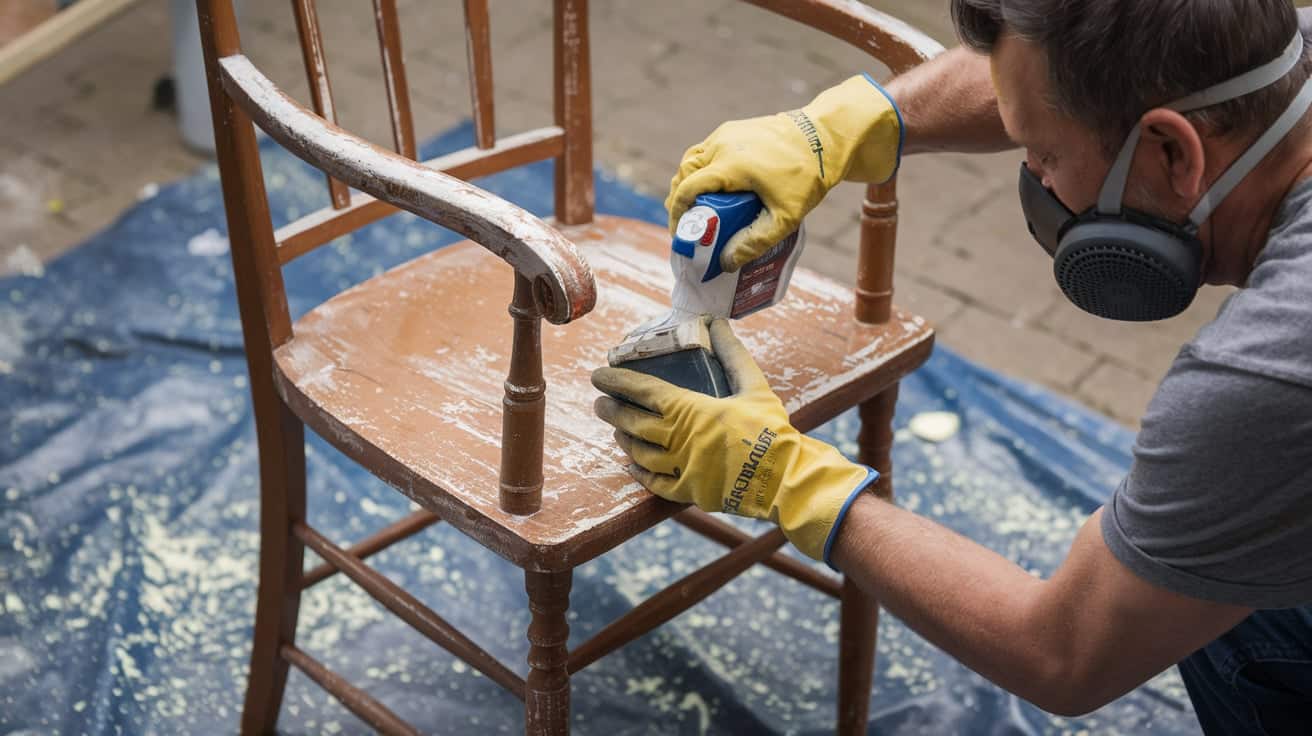Painting over beautiful wood grain is a tragedy many furniture lovers encounter. I’ve seen countless pieces with stunning walnut, mahogany, or oak hidden beneath layers of paint that shouldn’t be there. If you’ve found a painted piece with potential, I understand your frustration.
Fortunately, stripping paint doesn’t have to be complicated or intimidating. With the right tools and technique, you can reveal the natural beauty underneath.
In this guide, I’ll share my trusted paint-stripping method that turned a $40 thrift store dresser into a stunning wooden centerpiece.
Here, you’ll find the most effective products, instructions for using them correctly, and easy steps for reviving wooden furniture without harming the surface.
Tools and Materials Required to Strip Paint
| Tool | Purpose |
|---|---|
| Paintbrush (for stripper/oil) | Applying paint stripper and tung oil |
| Gloves | Protect hands from chemicals |
| Mask | Protect from fumes (especially indoors) |
| 5-in-1 painter’s tool/scraper | Scraping off paint |
| Sandpaper (120 & 600 grit) | Smoothing surface during stripping/refinishing |
| Steel wool (alternative) | Fine sanding and smoothing |
| Cotton rags | Applying oil, cleaning surface |
| Old rags and paper towels | Cleanup and wiping during the process |
| Material | Purpose |
|---|---|
| Citrus Strip paint stripper | Removes old paint or finish |
| Plastic wrap/saran wrap | Keeps stripper moist for better penetration |
| Paper bags | Disposal of removed paint |
| Mohawk spray cleaner | Removes wax and grime before refinishing |
| Tung oil | For finishing and protecting the wood |
| Wood glue | Repairs for any broken parts (e.g., drawers) |
| Mohawk drawer lubricant | Smooth drawer operation |
| Replacement knobs (optional) | Updating or replacing old hardware |
Step-By-Step Procedure to Make Strip Paint
Step 1. Preparation
Proper preparation is essential before diving into paint stripping. Find a well-ventilated workspace, preferably outdoors, where chemical fumes can dissipate.
Protect yourself with chemical-resistant gloves, and consider wearing a mask, especially if working indoors. Have disposal materials ready paper bags work well for collecting scraped paint. Gather all your tools beforehand so you’re not scrambling mid-project.
Step 2. Paint Stripping Process
Apply a thick coat of Citrus Strip using a paintbrush, focusing on horizontal surfaces to prevent dripping. Cover with plastic wrap to avoid evaporation and improve effectiveness. Let the stripper work for 1-24 hours until you see the paint bubbling up from the surface.
Once the paint loosens, carefully scrape it off using a 5-in-1 tool or plastic scraper, working in the direction of the wood grain. Dispose of paint in paper bags. For stubborn areas, apply a second coat of stripper and repeat the process.
After scraping, wipe the surface clean with rags to remove residual stripper. Sand the bare wood with 120-grit sandpaper, always following the grain. Clean the surface with a spray cleaner to remove any remaining dust or residue.
Step 3. Refinishing with Tung Oil
Apply the first coat of tung oil with a brush, allowing it to penetrate for about 15 minutes. Wipe away excess oil with a clean cotton rag and let it dry for 24 hours. Before the next coat, lightly sand with 600-grit paper or steel wool and clean the surface.
Repeat this process 2-3 times for a richer finish, allowing proper drying time between coats. Tung oil penetrates the wood rather than sitting on top, creating a natural water-resistant finish that enhances the grain’s beauty.
Step 4. Drawer Repairs
For loose dovetail joints, apply wood glue, clamp until dry, and wipe away excess immediately. This ensures structural integrity for continued use. Apply drawer lubricant to sides and rails for smooth operation without sticking or wear.
Consider hardware options that complement the wood’s natural beauty. In the example project, modern glass knobs were selected to highlight the brass keyhole escutcheons without competing with the gorgeous wood grain.
For a visible go-through, check out the YouTube video by Charlotte’s House
Common Mistakes to Avoid
- Using an expired or ineffective stripper: The first stripper she tried didn’t work well; always check product freshness.
- Not wearing proper protection: Always wear gloves when working with strippers. Consider wearing a mask, especially in enclosed spaces.
- Being too aggressive with metal scrapers: This can damage the wood veneer; use plastic scrapers for delicate surfaces. Patience pays off here.
- Rushing the process: Paint stripping requires patience. Always follow the recommended wait times for the stripper to effectively break down the layers without damaging the wood underneath.
- Sanding against the grain: Sanding against the grain can leave unsightly scratches and permanent marks on your furniture. To maintain a smooth, professional finish, always sand in the direction of the wood grain, especially during final refinishing steps.
When to Strip vs. When to Sand
Choosing between stripping and sanding depends on your specific project. Stripping is best when dealing with multiple layers of paint, detailed furniture with carvings, or valuable antiques where you want to preserve details. It’s also ideal for revealing the natural wood grain beneath painted surfaces.
Sanding works better for thin layers of paint, flat surfaces without intricate details, or when you plan to repaint anyway. It’s also the go-to method when you’re working with veneer or when the piece has minimal paint coverage.
Consider stripping when you want to preserve the wood underneath and sanding when you’re more concerned with creating a smooth surface for a new finish. For the best results on heavily painted furniture, combine both: strip first to remove the bulk of the paint, then lightly sand for a perfect finish.
Conclusion
Stripping paint from old furniture isn’t just about restoration; it’s about uncovering hidden stories and beauty.
With Citrus Strip, proper tools, and patience, you can transform painted pieces into stunning wood showcases.
Remember to work in a ventilated area, wear protection, and follow the wood’s grain during every step.
Please don’t rush the process, whether it’s letting the stripper work overnight or applying multiple coats of tung oil. The results are worth the wait.
Ready to reveal the natural beauty beneath layers of paint?
Grab your supplies and give that thrift store find new life.
Frequently asked questions
1. What Is the Best Thing to Remove Paint With?
Citrus Strip is the best paint remover for most furniture projects. It’s less toxic than traditional strippers, has minimal fumes, and works effectively when left on overnight. Plus, it can be used indoors safely.
2. What Household Items Can Strip Paint?
Household items that can strip paint include vinegar (especially for water-based paints), baking soda paste, rubbing alcohol, and boiling water for metal surfaces. For stubborn stains, try heat from a hairdryer or steam from a clothing steamer.
3. What Paint Cannot Be Removed?
Some epoxy-based paints, certain industrial coatings, and paint that has fully bonded with porous surfaces can be extremely difficult to remove completely.












